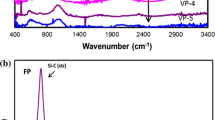Abstract
Amorphous hydrogenated silicon carbide has been studied extensively because of its properties as a wide bandgap material. However, a large amount of methane is needed to deposit the material. Also, the high carbon content of these films poses some problems. The addition of NF3 to the gas stream results in wide bandgap films with a substantial reduction in the required CH4 flow for deposition. Amorphous SiCxNy:H:F films were prepared using rf glow discharge decomposition of silane, methane, and nitrogen trifluoride in a parallel-plate stainless steel reactor. Gas flow rate and power density were varied. For a gas mixture containing 6% NF3 and 78% CH4, FTIR measurements reveal a reduction in C-H peak heights at 2960 cm−1 and 2880 cm−1 with respect to the Si-H peak at 2080 cm−1 indicating a smaller carbon content in the film. The C-H peaks shift to higher wavenumbers with increasing NF3. The use of NF3 increases the bandgap from 2.6 to 3.14 eV while reducing the refractive index from 2.12. to 1.87. A maximum deposition rate of 625 Å/min was achieved. This should be compared to the very low deposition rate of 18 Å/min for comparable bandgap Si-C films deposited using 97% methane in silane. Increasing the deposition power density resulted in a larger bandgap and a smaller refractive index.
Similar content being viewed by others
References
D.L. Williamson, A.H. Mahan, B.P. Nelson, and R.S. Crandell, Appl. Phys. Lett. 55, 8 (1989).
H.C. Goh, S.M. Tan, K. Ng, H.A. Naseem, W.D. Brown, and A.M. Hermann, in Amorphous Silicon Technology, eds. P.C. Taylor, M.J. Thompson, P.G. LeComber, Y. Hamakawa, and A. Madan (Mat. Res. Soc. Symp. Proc. 192, Pittsburgh, PA 1990), p.75.
A.H. Mahan, P. Raboisson, D.L. Williamson, and R. Tsu, Solar Cells 21, 117, (1987).
A.H. Mahan, P. Raboisson, R. Tsu, Appl. Phys. Lett. 50, 335 (1987).
W.C. Mohr, C.C Tsai, and R.A. Street, in Amorphous Silicon, (Mat. Res. Soc. Symp. Proc. 70, Pittsburgh, PA 1986}), p. 319.
Acknowledgement
We are grateful to Dr. G. Blyholder of the Chemistry Dept., University of Arkansas for the use of the FTIR. This work is partially supported by NASA/Lewis Research Center, Grant No. NAG 3-802.
Author information
Authors and Affiliations
Rights and permissions
About this article
Cite this article
Goh, H., Tan, S., Naseem, H. et al. Wide Bandgap Fluorinated Silicon-Carbide-Nitride Films Using NF3. MRS Online Proceedings Library 219, 763–768 (1991). https://doi.org/10.1557/PROC-219-763
Published:
Issue Date:
DOI: https://doi.org/10.1557/PROC-219-763




